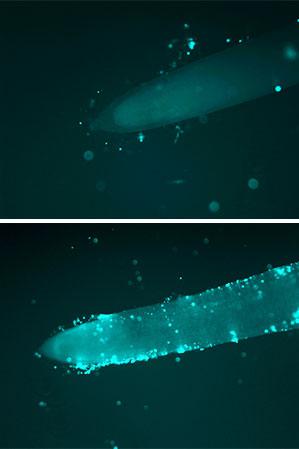Researchers from Sweden have created genetically modified rice with increased yields and reduced greenhouse gas emissions
 Bashny.Net
Bashny.Net

Rice fields i>
Researchers from the Swedish University of Agricultural Sciences встроили in rice gene from barley , thus yielding crops with increased yield and reduced emissions of methane - a gas involved in the greenhouse effect.
The roots of rice growing in flooded rice fields emit organic substances. These substances serve as food for microorganisms that produce during their life methane. Of course, it is not concerned about the farmers and rice yield - but scientists just worried about global warming and the greenhouse effect, in which the important role played by emissions of CH 4 sub>.
study conducted back in 2002 , prompted advantageous for all parties to solve the problem: if rice output smaller roots, and with the upper part - a little more, then yields will rise, and methane will be released not so active.
It managed to do this and our heroes - scientist Yong Su, Changkuan Hu and Xiao Yang. Barley gene causes SUSIBA2 Fig redistribute energy so that the top part of a plant, including seeds, grows much more active, because the top of the plants accumulate more carbohydrates.
According to the results of experiments in which genetically modified crops were grown in various climates China, it was found that production of methane decreased by from 90% to 99%, by significantly reducing the number of microbes. A yield through more powerful top of the increases by about 50%.

Top - the root of GMO rice, below - normal. One can see the difference in the number of microorganisms i>
The content of methane in the atmosphere is small (% 0, 0002 by volume), and for a long time, its impact on the greenhouse effect generally did not attach importance. But then it turned out that this greenhouse gas has the ability to much stronger infrared absorbing the earth's surface than carbon gas of the same mass, and its content in the atmosphere is increasing rapidly. This rice fields with their agents - is the largest source of methane, their contribution is about 25% of the methane in the atmosphere emerging.
The work, published in the journal Nature, commented Paul Bodélé Depression, a researcher at the Netherlands Institute of Ecology of microorganisms. In general, he praised the work of the experts of the Swedish Institute, but pointed out that it is necessary to conduct further experiments to confirm the possibility of widespread distribution of the new culture. The ecological balance - a very difficult thing, and a serious reduction in the number of microbes can affect other aspects of crop growth - for example, the need to increase the amount of fertilizer or reduced resistance to disease culture.
But thanks to the opponents of genetically modified foods, panicky afraid of all crops produced "in vitro", even after the successful testing of such rice will immediately sell to farmers for planting. Как explained in an interview with one of the researchers, they have to bring the exact same figure "normal" way of breeding. It will be exactly the same, and even contains the same gene - but such "traditional" way to be more acceptable to society. And this is a slow process and can take anywhere from 5 to 10 years.
Source: geektimes.ru/post/259510/
Tags
See also
Scientists were able to create metallic hydrogen
Scientists have created a fundamentally new type of speaker from graphene
Looking novih energy sources
11 interesting facts about the production of malt
In Iceland, learned to turn carbon emissions to stone. The Project CarbFix
Three steps on the way to food well-being of the planet
We tend to associate happiness with consumption: why we bought, buy and will continue to buy
Counter-Strike
It completed the most extensive study of the impact of GMOs on human health

















